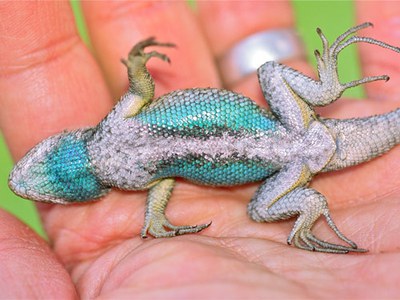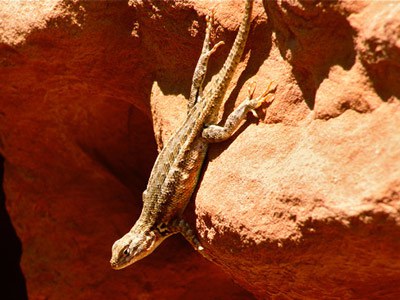Along the trails at Deschutes Land Trust Preserves, it is likely that the most commonly seen reptile is the Western Fence Lizard (Sceloporus occidentalis). This 4 to 7 inch long animal’s upper sides are dull grayish-brown to nearly black, with some dark, squiggly blotches. The muted earth colors blend well with the surrounding semi-arid environment and could be considered rather “blah.” However, the flip-side of this critter is contrastingly different. The abdomen and throat have beautiful patches of gaudy blue (less vivid on females). These colorfully shiny scales make them appear to be adorned with turquoise jewelry. There’s also a tinge of orangish-yellow under the front and rear legs. Males are especially conspicuous because they perform territorial displays of bobbing up and down, along with tilting sideways to show their bright blue bellies.

In Central Oregon, this species occurs at elevations below 5,000 to 6,000 feet, inhabiting dry, brushy areas and sparse, sun-bathed sections of juniper/pine woodlands. They can be observed basking on rocks, logs, stumps, and wooden fence posts--hence, the common name.

Both species have much the same dietary preferences. Insects and spiders are primarily eaten, but occasionally they vary things by snacking on dinky scorpions. Likewise, these two members of the genus Sceloporus reproduce similarly, being egg-layers (oviparous). During early summer, pregnant females seek out a sun-warmed section of soil or crumbly, rotting log to dig a shallow hole and deposit several leathery-shelled little eggs. Mother lizard then merely refills the depression and leaves it to solar-incubate, providing no maternal care. Later in August and early September, the tiny lizards hatch and dig their way out, ready to fend for themselves.
Read more by Al St. John:
A native Oregonian, Alan D. St. John lives in sage-scented juniper woodlands near Bend with his wife, Jan. Al is a freelance interpretive naturalist who uses writing, photography, and drawings to teach about the natural world. Specializing in herpetology, he has worked as a reptile keeper at Portland's zoological park, and conducted extensive reptile and amphibian field surveys for the Oregon Department of Fish and Wildlife, USDA Forest Service, the U. S. Department of the Interior's Bureau of Land Management, and the National Park Service. Along with authoring the books, Reptiles of the Northwest and Oregon's Dry Side: Exploring East of the Cascade Crest, his work has appeared in National Geographic, Outdoor Photographer, Ranger Rick, Natural History, Country, Nature Conservancy, The New York Times, and other periodicals.


